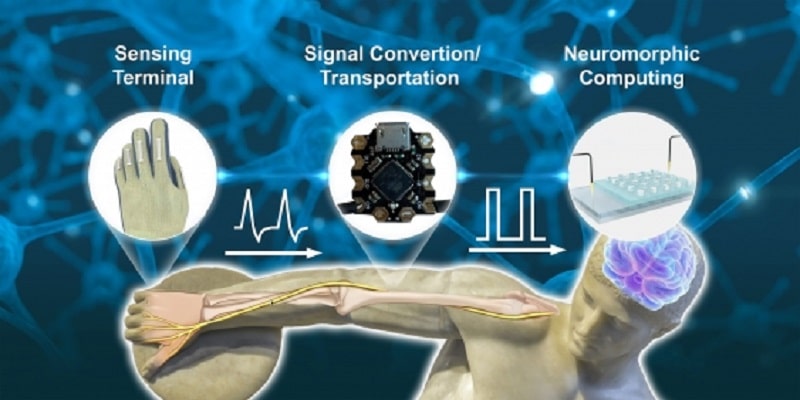Artificial skins are emerging as a transformative sensing technology to meet the rising demands for real-time monitoring of vitals, including blood pressure, temperature, and oxygen levels. In addition to their uses in healthcare settings, electronic skins (E-Skins) could be used to measure the health status of athletes and people working in hazardous environments.
Recently, stretchable strain sensors have been developed to mimic human skin perception by measuring pressure, tension, and weight. The existing sensors can detect and convert external stimuli into electrical signals.
However, most of these sensors don’t have the capability to actually process the signals. To do that, it would require another processor, which would consume a lot of electric power. So, without processing functionality, these sensors alone are unable to match human skin’s sensory function.
To overcome the limitations of current artificial perceptual systems, the team of researchers turned to the human nervous system for inspiration. Researchers at UNSW Sydney have developed an electronic device that is able to detect mechanical stimuli for information processing, including gesture and handwriting recognition, with ultra-low power consumption. They have combined artificial synapses with advanced sensors to mimic the properties of human skin.
In biological nerve systems, sensory organs such as the skin can detect stimuli, and the generated signals can then be transmitted to the human brain via neurons and synapses for processing and, eventually, response.

With the new devices, people can feel pressure and pain and interact with the surrounding environment through physical contact via the skin. With further development, this technology could find applications in a range of fields, including elderly care, extreme sports monitoring, and motion capture.
“The electric current that powers our device corresponds to the strength of the connection between two neurons. And we applied electric stimuli to control the device conductance to emulate human synaptic behaviors,” says Professor Dewei Chu, lead author of the study. Using artificial neurons in this way is known as neuromorphic computing.
The system consists of a neuromorphic computing device combined with highly responsive sensors. The sensors are highly sensitive to any applied strain, and different electrical signals will be generated under various deformations. They can detect subtle human motion and monitor physiological signals, including wrist pulse, respiration, and vocal cord vibration. The neuromorphic computing device can detect the stimuli and interpret the sensing information for gesture recognition.
“This work offers new insights in designing artificial synapses and sensors to process and recognize information for neuromorphic computing and artificial intelligence applications,” says Prof. Chu. “For example, it offers promising potential for the advancement of smart wearable technology that could detect body movement or could be applied to soft robotics and prosthetics.”
This research marks an important advancement in the development of e-skins, but there is still work to be done before we begin to see it used in our everyday lives. The perceptual system can recognize simple gestures with a high success rate, such as thumbs up or a fist. However, some complex gestures are difficult to identify, requiring further modification of materials and device structures.
“Now we want to focus on improving the sensing and information processing capabilities of the system and further expand the application in tactile and visual perception,” says Prof. Chu.
Journal reference:
- Fandi Chen, Shuo Zhang, Long Hu, Jiajun Fan, Chun-Ho Lin, Peiyuan Guan, Yingze Zhou, Tao Wan, Shuhua Peng, Chun-Hui Wang, Liao Wu, Teri McLean Furlong, Nagarajan Valanoor, Dewei Chu. Bio-Inspired Artificial Perceptual Devices for Neuromorphic Computing and Gesture Recognition. Advanced Functional Materials, 2023. DOI: 10.1002/adfm.202300266
Researchers develop technology to mimic the function of human skin
Source: Tambay News

0 Comments